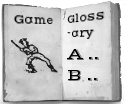Corkball
| Game | Corkball |
|---|---|
| Game Family | Fungo |
| Location | St. Louis |
| Regions | US |
| Eras | Derivative, Post-1900, Contemporary |
| Invented | No |
| Tags | |
| Description | Evidently primarily a St. Louis pastime, Corkball is presumably derived from baseball, involving down-sized bats and balls. The ball is pitched overhand from a distance of 55 feet. There is no running, but imaginary runners advance on hits by succeeding batters. Hit balls are defined as singles, and sometimes as longer hits, depending on where they land. Caught flies are outs. The game is said to have originated over a century ago among brewery workers using broomsticks and the bungs [corks] used to seal beer barrels. Team sizes vary from two to five players. Annual tournaments have been held at least through 2012. Dedicated corkball fields are reportedly found in St. Louis. When played with tennis balls, the game is sometimes called Fuzz-Ball. Some additional 2013 data from Corkball fan Jeff Kopp in St. Louis: [] The game was reportedly first played in about 1890. [] There are four active clubs in St.L, and pickup games appear on many Sundays at the Don Young Corkball Fields at Jefferson Barracks Park. [] Special balls and bats are supplied by the Markwort Sporting Goods Company. [] Isolated reports of corkball play are found in other US locations. Drummer Butch Trucks, a nephew of Tiger pitcher Virgil Trucks and founding member of the Allman Brothers Band, reportedly played corkball in Jacksonville FL and taught his band-mates the game. Another account places the game in an area from St. Louis "only" north to Springfield IL. A Chicago Corkball Club was reportedly active around 2010. [] Another form of the game, played with bottle caps in place of balls/corks, is called Bottle Caps.
|
| Sources | Special thanks to Jeff Kittel, emails of 10/11/09 and 9/22/13, for material on this game. A website on corkball is found at http://www.playcorkball.com, as accessed 9/25/13. It includes a 2012 paper on the history and context of the game. Its author, Jeff Kopp, sent us many further details (outlined above) in a 10/16/2013 email. See also http:///www.angelfire.com/sports/corkball/STLhistory.htm. Accessed 10/8/09. This article includes a description of corkball rules and a corkball chronology that shows the addition of balls and strikes in 1941 and of extra-base hits in 1965. |
| Source Image | [[Image:|left|thumb]] |
| Comment | Edit with form to add a comment |
| Query | Edit with form to add a query |
| Has Supplemental Text |
Comments
<comments voting="Plus" />
